Influence of Atmospheric Flow Structure on Optical Turbulence Characteristics
Abstract
:1. Introduction
- (i)
- The correct accounting of large-scale advections and diurnal transformations of air masses in domains with relatively high horizontal resolution.
- (ii)
- Reproducibility of meso-scale structures affecting small-scale turbulence.
- (iii)
- The reconstruction of vertical profiles of air temperatures and wind speeds with high temporal and vertical resolution. Using gradient approaches, these data make it possible to estimate the vertical profiles of optical turbulence, as well as the Fried parameter and seeing.
- (iv)
- (v)
- Clarification of spatial locations with the best astroclimatic parameters.
2. Used Methods
2.1. Adaptation of the Weather Research and Forecasting Model within the Baikal Astrophysical Observatory Region
- (i)
- The largest domain had a coarse grid with a horizontal resolution of 8 km over a 1600 × 1600 km area. The largest domain covered Lake Baikal, the Eastern Sayan mountains and surrounding areas, and included radio sounding stations (Angarsk and Nizhneudinsk).
- (ii)
- The nested domain with a ratio of 1/4 corresponded to a 400 × 400 km area. The horizontal resolution in the domain was 2 km.
- (iii)
- The smallest domain above the BAO had a fine horizontal resolution of 500 m. The area of interest was limited to 100 × 100 km.
- (iv)
- There were 44 vertical levels, with higher resolution within the lower layers of the atmosphere. The number of height levels, up to 3100 m, was 12 (Figure 1). In higher layers of the atmosphere, the simulation was performed up to 30,800 m.
2.2. Method to Estimate the Strength of Small-Scale (Optical) Turbulence
3. Integral Strength of Optical Turbulence and Spatial Distributions of Surface Wind Speeds over the BAO
Analysis of Structure of Atmospheric Flows in the Lower Layers
4. Discussion
5. Conclusions
- (i)
- We adapted the WRF model for the Baikal Astrophysical Observatory and Sayan Solar Observatory region. We shown that the YSU parametrization scheme reproduced the local air circulation during the day. The reproducibility of atmospheric parameters in the WRF model deteriorated under stable thermal stratification of the atmosphere. The same issue was pointed out in [38], which was a fine-resolution WRF simulation of stably stratified flows in shallow pre-alpine valleys. The authors found that the diurnal temperature range was underestimated in the WRF model;
- (ii)
- The structure of turbulence over the BAO significantly depended on the orography and characteristics of meso-scale atmospheric disturbances (vortex and jet streams). The BAO is located at the periphery of a meso-scale atmospheric vortex structure with an anticyclonic direction of air flows in the daytime. An analysis of the energy spectra showed that the characteristic scales of this meso-scale vortex structure, whose center is formed north of the BAO, vary from 10 to 20 km;
- (iii)
- We showed that the increase in image quality was due to weakening of the airflow over Lake Baikal, as well as a decrease in meso-scale wind speed fluctuations. In comparison with nighttime characteristics, the daytime spectral characteristics of the wind speed fluctuations, and , increased 2.5–3.3 and 2.0–3.4 times, respectively. The energy of high-frequency fluctuations in wind speed during the day also significantly increased.
- (iv)
- We showed that the daytime spectrum of atmospheric meso-scale turbulence was close to the classical spectrum of strong turbulence (described by the “−5/3” law). At night and in the morning, the spectrum has a steeper slope on small scales. The spatial scales, based on which the spectrum changes its slope from “−5/3” to ∼ “−3”, are associated with the suppression of atmospheric turbulence in stably stratified atmospheric layers. The characteristic scales of the transition between different regions of the spectrum were 2–2.5 km.
Author Contributions
Funding
Institutional Review Board Statement
Informed Consent Statement
Data Availability Statement
Acknowledgments
Conflicts of Interest
References
- Wu, T.; Bos, W.J.T. Cascades of enstrophy and helicity in turbulence without vortex stretching. Phys. Rev. Fluids 2022, 7, 94601. [Google Scholar] [CrossRef]
- Vela-Martin, A. The energy cascade as the origin of intense events in small-scale turbulence. J. Fluid Mech. 2022, 937, A13. [Google Scholar] [CrossRef]
- Rajput, A.; Singh, N.; Sngh, J.; Rastogi, S. Investigation of atmospheric turbulence and scale lengths using radiosonde measurements of GVAX-campaign over central Himalayan region. J. Atmos. Sol.-Terr. Phys. 2022, 235, 105895. [Google Scholar] [CrossRef]
- Rodrigues, C.V.; Palma, J.M.L.M. Estimation of turbulence intensity and shear factor for diurnal and nocturnal periods with an URANS flow solver coupled with WRF. J. Phys. Conf. Ser. 2014, 524, 12115. [Google Scholar] [CrossRef] [Green Version]
- Dong, H.; Cao, S.; Ge, Y. Simulation of flow over complex terrain by coupling of WRF and LES. In Proceedings of the IABSE Young Engineers Colloquium in East Asia, Shanghai, China, 24 October 2018; pp. 56–58. [Google Scholar]
- Masciadri, E.; Vernin, J.; Bougeault, P. 3D numerical simulations of optical turbulence at the roque de los muchachos observatory using the atmospherical model Meso-Nh. Astron. Astrophys. 2001, 365, 699–708. [Google Scholar] [CrossRef] [Green Version]
- Cherubini, T.; Businger, S.; Lyman, R.; Chun, M. Modeling optical turbulence and seeing over Mauna Kea. J. Appl. Meteorol. Climatol. 2008, 47, 1140–1155. [Google Scholar] [CrossRef] [Green Version]
- Martynova, Y.V.; Zaripov, R.B.; Krupchatnikov, V.N.; Petrov, A.P. Estimation of the quality of atmospheric dynamics forecasting in the Siberian region using the WRF-ARW mesoscale model. Russ. Meteorol. Hydrol. 2014, 39, 440–447. [Google Scholar] [CrossRef]
- Kalinin, N.A.; Shikhov, A.N.; Bykov, A.V. Forecasting mesoscale convective systems in the Urals using the WRF model and remote sensing data. Russ. Meteorol. Hydrol. 2017, 42, 9–18. [Google Scholar] [CrossRef]
- Zaripov, R.B.; Martynova, Y.V.; Krupchatnikov, V.N.; Petrov, A.P. Atmosphere data assimilation system for the Siberian region with the WRF-ARW model and three-dimensional variational analysis WRF 3D-Var. Russ. Meteorol. Hydrol. 2016, 41, 808–815. [Google Scholar] [CrossRef]
- Zarochentsev, G.A.; Rubinstein, K.G.; Bychkova, V.I.; Ignatov, R.Y.; Yusupov, Y.I. Comparison of Several Numerical Methods for Fog Prediction. Atmos. Ocean. Opt. 2019, 32, 193–201. [Google Scholar] [CrossRef]
- Romanskiy, S.O.; Verbitskaya, E.M. Short-term high-resolution numerical weather prediction based on WRF–ARW model on the territory of Vladivostok City. Vestn. Far East. Branch Russ. Acad. Sci. 2014, 5, 48–57. [Google Scholar]
- Kalinin, N.A.; Bykov, A.V.; Shikhov, A.N. Object-Oriented Estimation of the Short-Term Forecast of Convective Hazardous Weather Events in Perm Krai by the WRF Model. Atmos. Ocean. Opt. 2022, 35, 423–433. [Google Scholar] [CrossRef]
- Zaiko, P.O. Meteorological data assimilation in mesoscale numerical model WRF-ARW in the republic of Belarus. Wschod. Czas. Nukowe 2020, 55, 4–12. [Google Scholar]
- Jayaraman, B.; Quon, E.; Li, J.; Chatterjee, T. Structure of Offshore Low-Level Jet Turbulence and Implications to Mesoscale-to-Microscale Coupling. J. Phys. Conf. Ser. 2022, 2265, 22064. [Google Scholar] [CrossRef]
- Nosov, V.V.; Lukin, V.P.; Kovadlo, P.G.; Nosov, E.V.; Torgaev, A.V. Intermittency of Kolmogorov and Coherent Turbulence in the Mountain Atmospheric Boundary Layer (Review). Atmos. Ocean. Opt. 2022, 35, 266–287. [Google Scholar] [CrossRef]
- Lukin, V.P.; Nosov, E.V.; Nosov, V.V.; Torgaev, A.V. Causes of non-Kolmogorov turbulence in the atmosphere. Appl. Opt. 2016, 55, B163–B168. [Google Scholar] [CrossRef]
- Wasson, G.; Das, S.; Panda, K. Numerical simulation of a Clear Air Turbulence (CAT) event over Northern India using WRF modeling system. Nat. Hazards 2022, 114, 2605–2631. [Google Scholar] [CrossRef]
- Giordano, C.; Vernin, J.; Trinquet, H.; Munoz-Tunon, C. Weather Research and Forecasting prevision model as a tool to search for the best sites for astronomy: Application to La Palma, Canary Islands. MNRAS 2014, 440, 1964–1970. [Google Scholar] [CrossRef] [Green Version]
- Diaz-Fernandez, J.; Bolgiani, P.; Sastre, M.; Santos-Munoz, D.; Valero, F.; Farran, J.I.; Martin, M.L. Ability of the WRF-ARW and HARMONIE-AROME models to detect turbulence related to mountain waves over Central Iberia. Atmos. Res. 2022, 274, 106183. [Google Scholar] [CrossRef]
- Yang, Q.; Wu, X.; Luo, T.; Qing, C.; Yuan, R.; Su, C.; Xu, C.; Wu, Y.; Ma, X.; Wang, Z. Forecasting surface-layer optical turbulence above the Tibetan Plateau using the WRF model. Opt. Laser Technol. 2022, 153, 108217. [Google Scholar] [CrossRef]
- Qian, X.; Yao, Y.; Zou, L.; Wang, H.; Yin, J.; Li, Y. Modelling of atmospheric optical turbulence with the Weather Research and Forecasting model at the Ali observatory, Tibet. MNRAS 2021, 505, 582–592. [Google Scholar] [CrossRef]
- Yang, Q.; Wu, X.; Han, Y.; Chun, Q.; Wu, S.; Su, C.; Wu, P.; Luo, T.; Zhang, S. Estimating the astronomical seeing above Dome A using Polar WRF based on the Tatarskii equation. Opt. Express 2021, 29, 44000–44011. [Google Scholar] [CrossRef]
- Kaul, C.M.; Hou, Z.J.; Zhou, H.; Rai, R.K.; Berg, L.K. Sensitivity Analysis of Wind and Turbulence Predictions With Mesoscale-Coupled Large Eddy Simulations Using Ensemble Machine Learning. J. Geophys. Res. Atmos. 2022, 127, e2022JD037150. [Google Scholar] [CrossRef]
- Skamarock, W.C.; Klemp, J.B.; Dudhia, J.; Gill, D.O.; Barker, D.; Duda, M.G.; Huang, X.-Y.; Wang, W.; Powers, J.G. A description of the advanced research WRF version 3. NCAR Tech. Note 2008. [Google Scholar] [CrossRef]
- Hagelin, S.; Masciadri, E.; Lascaux, F. Optical turbulence simulations at Mt Graham using the Meso-NH model. MNRAS 2011, 412, 2695–2706. [Google Scholar] [CrossRef] [Green Version]
- Wang, H.; Yao, Y.; Liu, L.; Qian, X.; Yin, J. Optical Turbulence Characterization by WRF model above Ali, Tibet. J. Phys. Conf. Ser. 2015, 595, 12037. [Google Scholar] [CrossRef] [Green Version]
- Odintsov, S.L.; Gladkikh, V.A.; Kamardin, A.P.; Nevzorova, I.V. Determination of the Structural Characteristic of the Refractive Index of Optical Waves in the Atmospheric Boundary Layer with Remote Acoustic Sounding Facilities. Atmosphere 2019, 10, 711. [Google Scholar] [CrossRef] [Green Version]
- Potekaev, A.; Krasnenko, N.; Shamanaeva, L. Diurnal Dynamics of the Umov Kinetic Energy Density Vector in the Atmospheric Boundary Layer from Minisodar Measurements. Atmosphere 2021, 12, 1347. [Google Scholar] [CrossRef]
- Ma, H.; Cao, X.; Ma, X.; Su, H.; Jing, Y.; Zhu, K. Improving the Wind Power Density Forecast in the Middle- and High-Latitude Regions of China by Selecting the Relatively Optimal Planetary Boundary Layer Schemes. Atmosphere 2022, 13, 2034. [Google Scholar] [CrossRef]
- Hu, X.-M.; Klein, P.M.; Xue, M. Evaluation of the updated YSU planetary boundary layer scheme within WRF for wind resource and air quality assessments. J. Geophys. Res. Atmos. 2013, 118, 10490–10505. [Google Scholar] [CrossRef]
- Botygina, N.N.; Kopylov, E.A.; Lukin, V.P.; Tuev, M.V.; Kovadlo, P.G.; Shikhovtsev, A.Y. Estimation of the astronomical seeing at the Large Solar Vacuum Telescope site from optical and meteorological measurements. Atmos. Ocean. Opt. 2014, 27, 142–146. [Google Scholar] [CrossRef]
- Lukin, V.P.; Botygina, N.N.; Antoshkin, L.V.; Borzilov, A.G.; Emaleev, O.N.; Konyaev, P.A.; Kovadlo, P.G.; Kolobov, D.Y.; Selin, A.A.; Soin, E.L.; et al. Multi-Cascade Image Correction System for the Large Solar Vacuum Telescope. Atmos. Ocean. Opt. 2019, 32, 597–606. [Google Scholar] [CrossRef]
- Souza, N.B.P.; Nascimento, E.G.S.; Moreira, D.M. Performance evaluation of the WRF model in a tropic region: Wind speed analysis at different sites. Atmosfera 2023, 36, 253–277. [Google Scholar] [CrossRef]
- Lysenko S., A.; Zaiko, P.O. Estimates of the Earth surface influence on the accuracy of numerical prediction of air temperature in Belarus using the WRF model. Hydrometeorol. Res. Forecast. 2021, 382, 50–68. [Google Scholar] [CrossRef]
- Weinkaemmerer, J.; Duran, I.B.; Schimdli, J. The Impact of Large-Scale Winds on Boundary Layer Structure, Thermally Driven Flows, and Exchange Processes over Mountainous Terrain. J. Atmos. Sci. 2022, 79, 2685–2701. [Google Scholar] [CrossRef]
- Di Bernardino, A.; Mazzarella, V.; Pecci, M.; Casasanta, G.; Cacciani, M.; Ferretti, R. Interaction of the Sea Breeze with the Urban Area of Rome: WRF Meso-scale and WRF Large-Eddy Simulations Compared to Ground-Based Observations. Bound.-Layer Meteorol. 2022, 185, 333–363. [Google Scholar] [CrossRef]
- de Bode, M.; Hedde, T.; Roubin, P.; Durand, P. Fine-Resolution WRF Simulation of Stably Stratified Flows in Shallow Pre-Alpine Valleys: A Case Study of the KASCADE-2017 Campaign. Atmosphere 2021, 12, 1063. [Google Scholar] [CrossRef]
- Obolkin, V.; Molozhnikova, E.; Shikhovtsev, M.; Netsvetaeva, O.; Khodzher, T. Sulfur and nitrogen oxides in the atmosphere of lake baikal: Sources, automatic monitoring, and environmental risks. Atmosphere 2021, 12, 1348. [Google Scholar] [CrossRef]
- Marinaite, I.; Penner, I.; Molozhnikova, E.; Shikhovtsev, M.; Khodzher, T. Polycyclic Aromatic Hydrocarbons in the Atmosphere of the Southern Baikal Region (Russia): Sources and Relationship with Meteorological Conditions. Atmosphere 2022, 13, 420. [Google Scholar] [CrossRef]
- Vemuri, A.; Buckingham, S.; Munters, W.; Helsen, J.; vn Beeck, J. Sensitive analysis of meso-scale simulations to physics parametrizations over the Belgian North Sea using Weather Research and Forecasting—Advanced Research WRF (WRF-ARW). Wind Energ. Sci. 2022, 7, 1869–1888. [Google Scholar] [CrossRef]

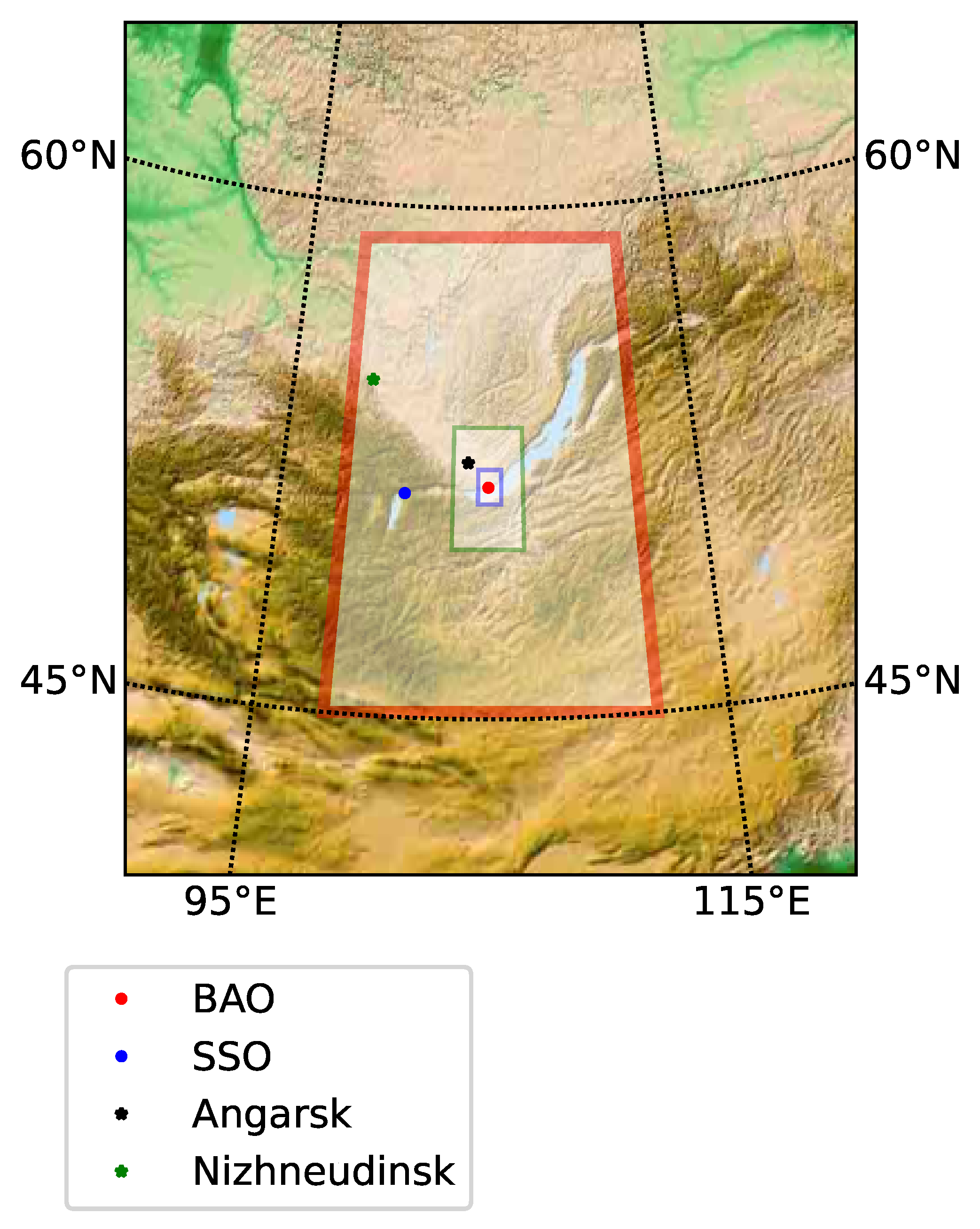
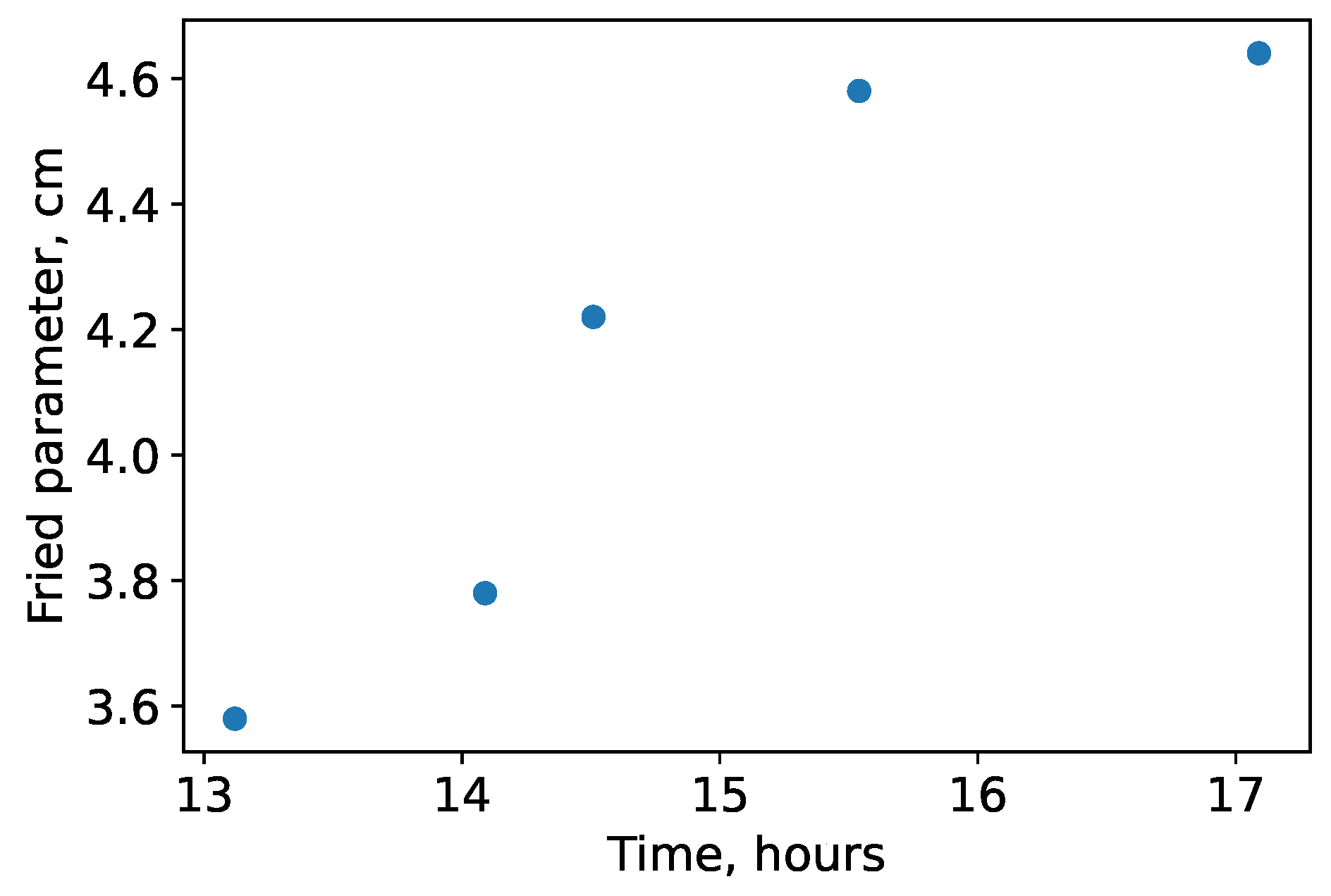
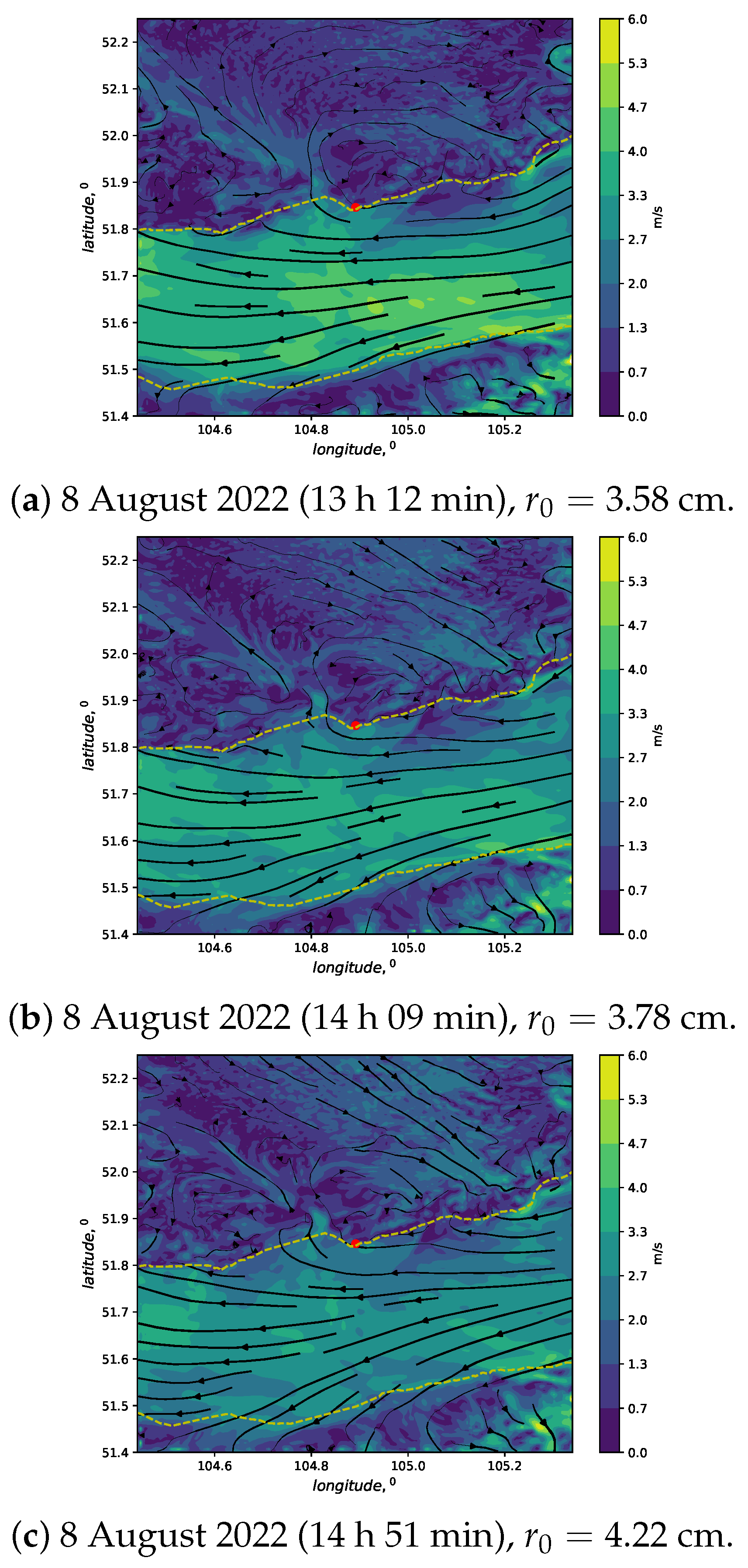
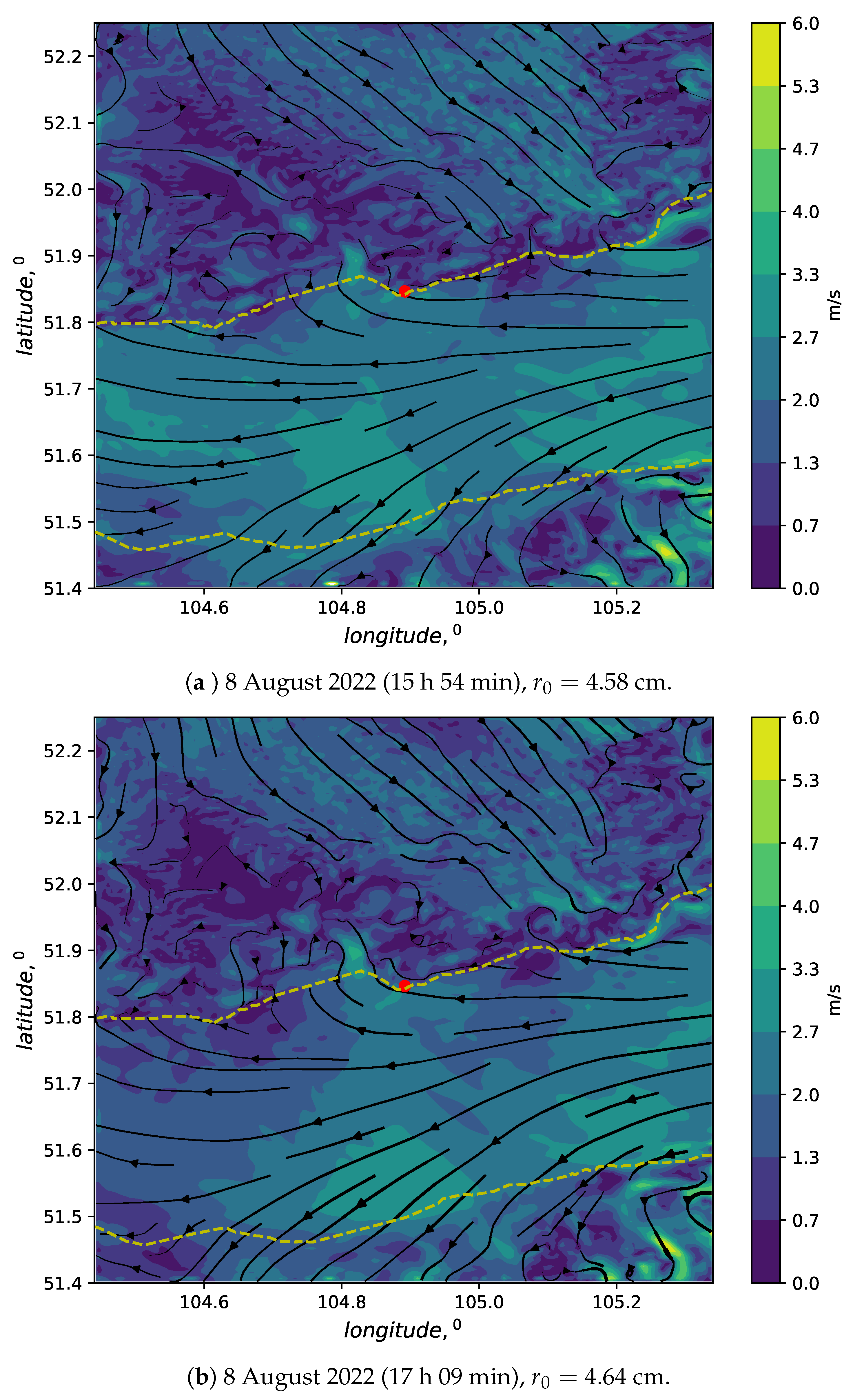

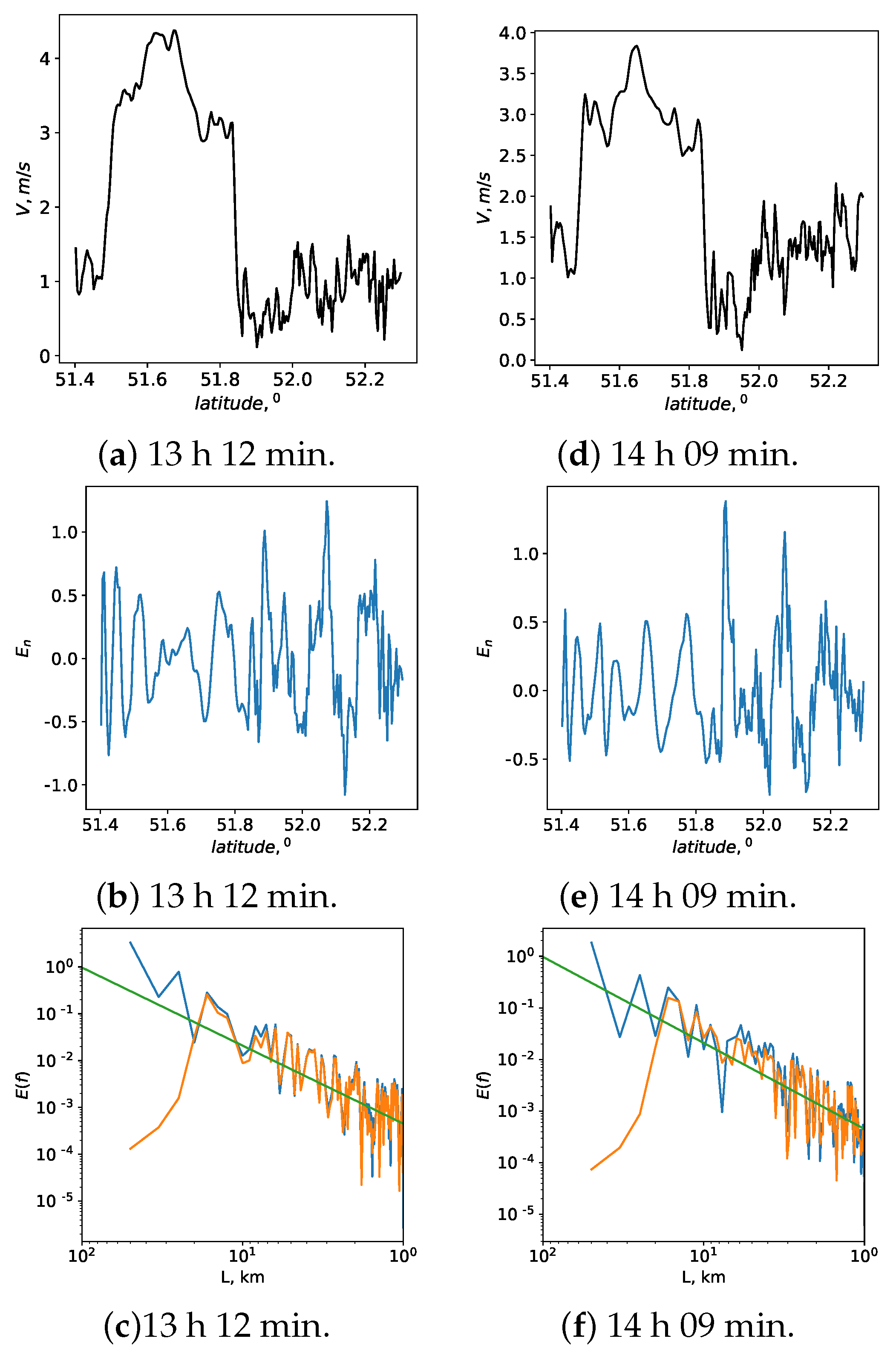
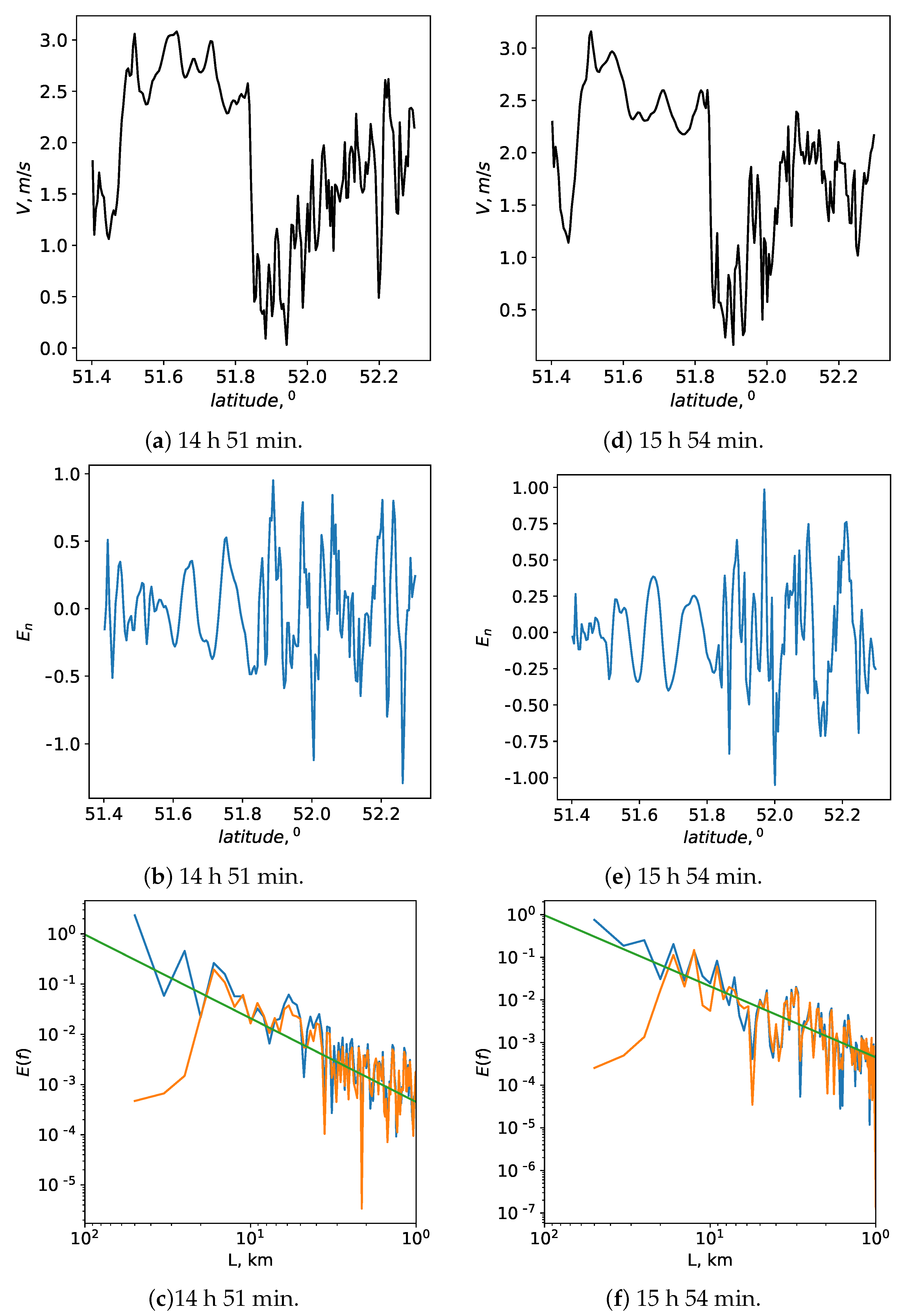

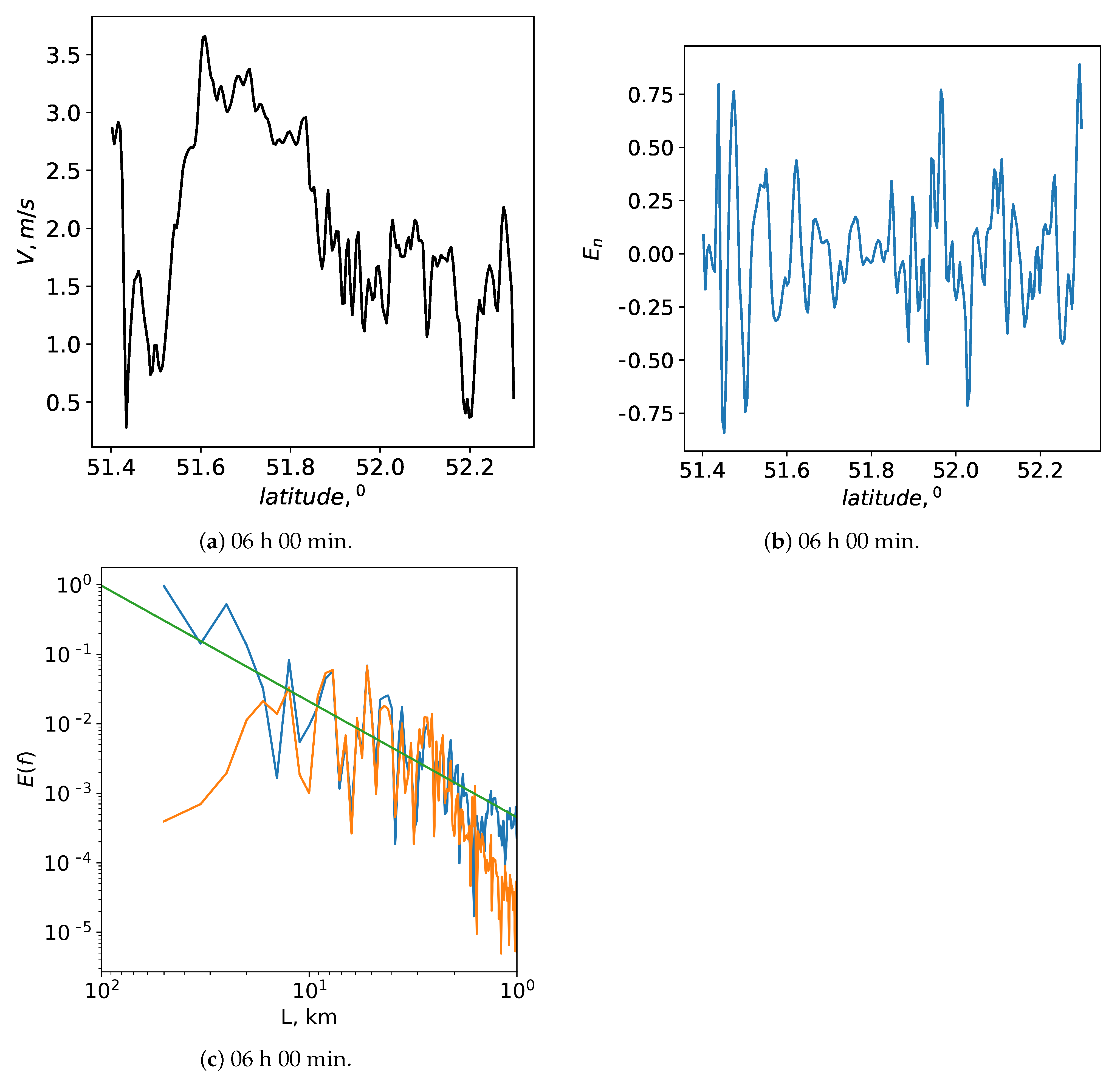
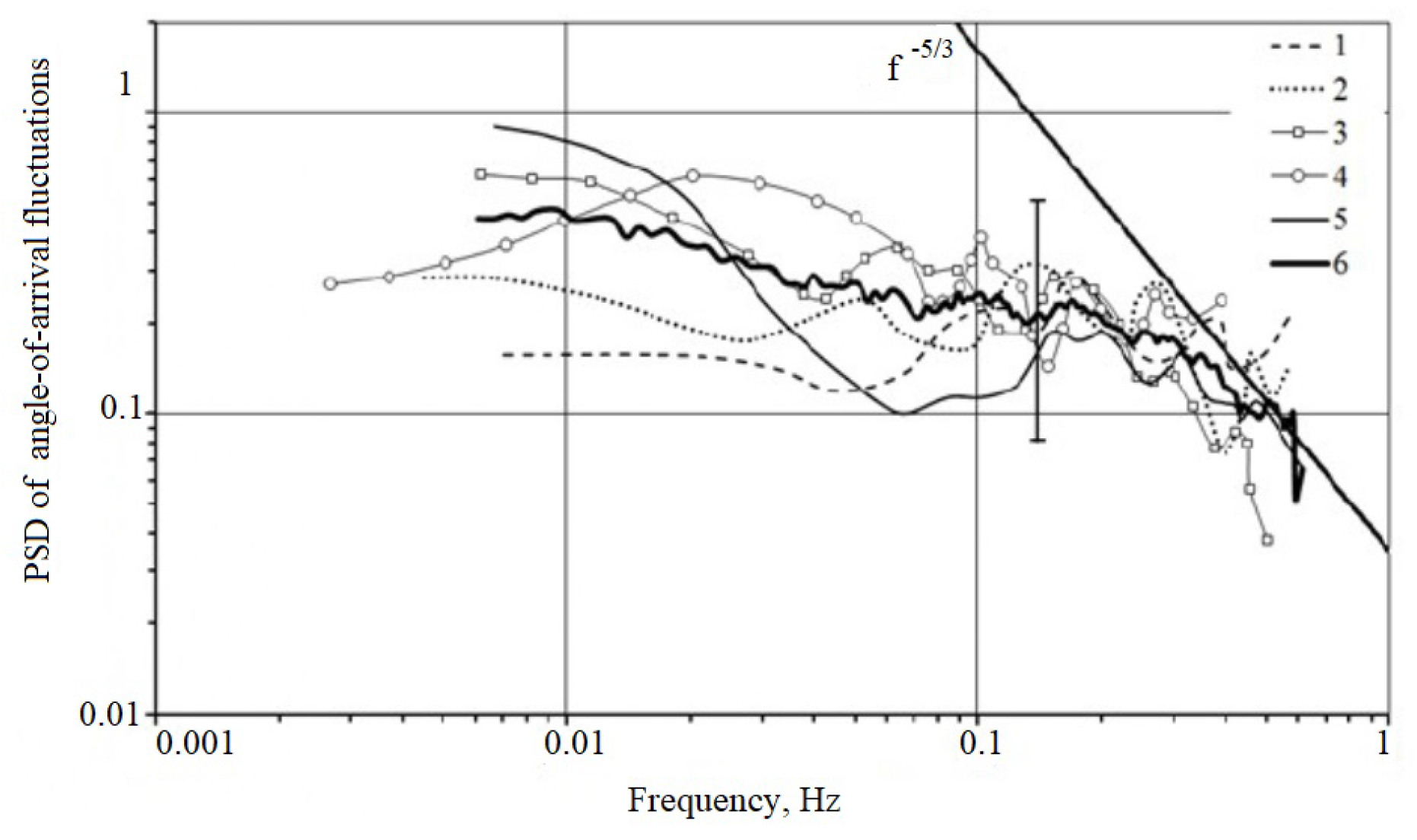
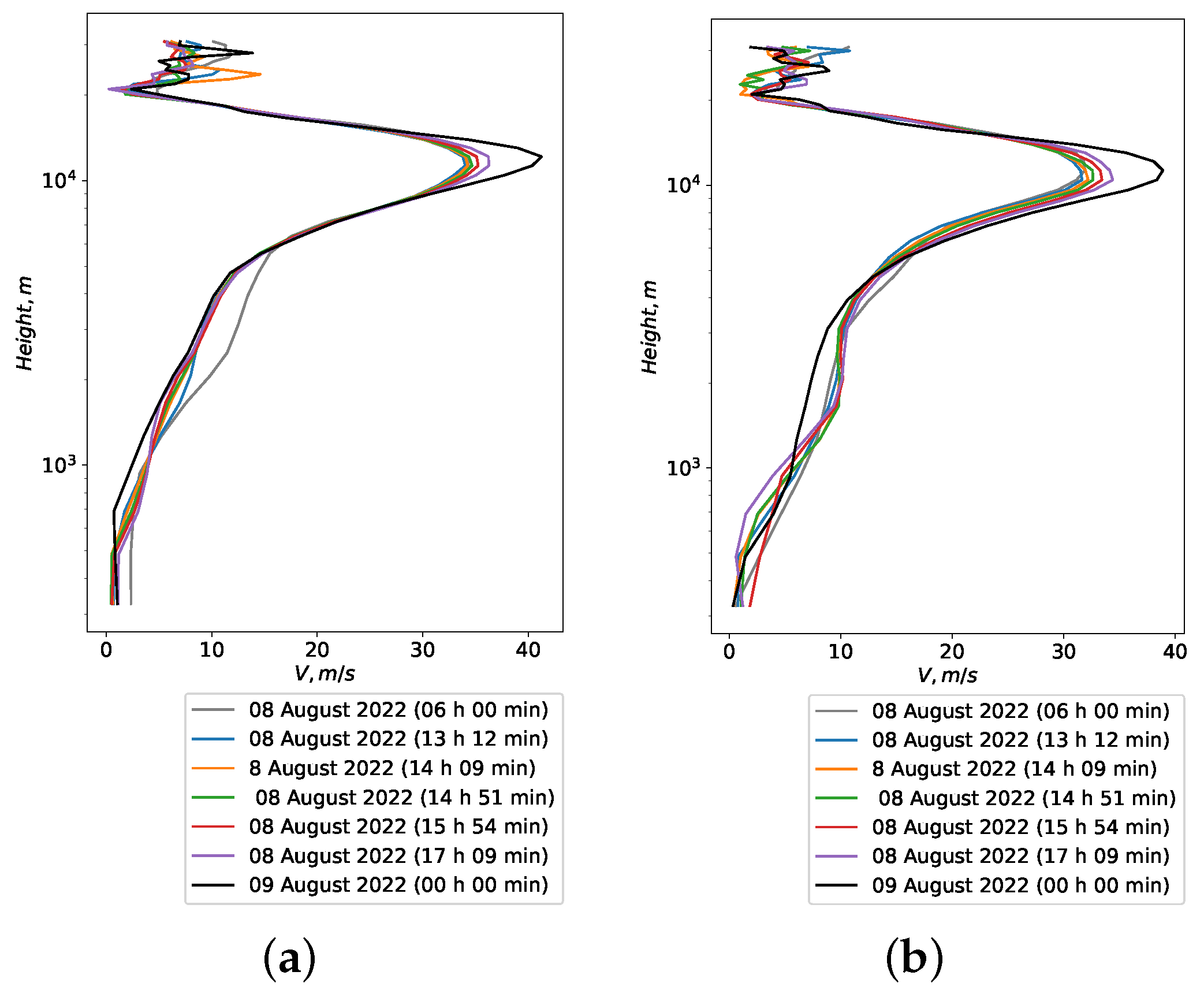
| Physical Schemes of Parametrization | Description |
|---|---|
| Yonsei University scheme | Atmospheric boundary layer |
| MM5-similarity scheme | Surface layer |
| Kain–Fritsch scheme | Cloudiness |
| Simple scheme based on Dudhia | Short-wave radiation |
| Rapid Radiative Transfer Model scheme | Long-wave radiation |
| Thompson scheme | Microphysical processes in clouds |
| RUC scheme | Land surface model |
| Time | , m/s | ||
|---|---|---|---|
| 8 August | |||
| 06 h 00 min | 2.7 | 0.38 | 0.51 |
| 13 h 12 min | 3.3 | 1.00 | 1.00 |
| 14 h 09 min | 2.9 | 0.93 | 0.85 |
| 14 h 51 min | 2.6 | 0.91 | 0.78 |
| 15 h 54 min | 2.3 | 0.77 | 0.65 |
| 17 h 09 min | 2.1 | 0.85 | 0.76 |
| 9 August | |||
| 00 h 00 min | 1.7 | 0.34 | 0.29 |
Disclaimer/Publisher’s Note: The statements, opinions and data contained in all publications are solely those of the individual author(s) and contributor(s) and not of MDPI and/or the editor(s). MDPI and/or the editor(s) disclaim responsibility for any injury to people or property resulting from any ideas, methods, instructions or products referred to in the content. |
© 2023 by the authors. Licensee MDPI, Basel, Switzerland. This article is an open access article distributed under the terms and conditions of the Creative Commons Attribution (CC BY) license (https://creativecommons.org/licenses/by/4.0/).
Share and Cite
Shikhovtsev, A.Y.; Kovadlo, P.G.; Lezhenin, A.A.; Korobov, O.A.; Kiselev, A.V.; Russkikh, I.V.; Kolobov, D.Y.; Shikhovtsev, M.Y. Influence of Atmospheric Flow Structure on Optical Turbulence Characteristics. Appl. Sci. 2023, 13, 1282. https://doi.org/10.3390/app13031282
Shikhovtsev AY, Kovadlo PG, Lezhenin AA, Korobov OA, Kiselev AV, Russkikh IV, Kolobov DY, Shikhovtsev MY. Influence of Atmospheric Flow Structure on Optical Turbulence Characteristics. Applied Sciences. 2023; 13(3):1282. https://doi.org/10.3390/app13031282
Chicago/Turabian StyleShikhovtsev, Artem Y., Pavel G. Kovadlo, Anatoly A. Lezhenin, Oleg A. Korobov, Alexander V. Kiselev, Ivan V. Russkikh, Dmitrii Y. Kolobov, and Maxim Y. Shikhovtsev. 2023. "Influence of Atmospheric Flow Structure on Optical Turbulence Characteristics" Applied Sciences 13, no. 3: 1282. https://doi.org/10.3390/app13031282
APA StyleShikhovtsev, A. Y., Kovadlo, P. G., Lezhenin, A. A., Korobov, O. A., Kiselev, A. V., Russkikh, I. V., Kolobov, D. Y., & Shikhovtsev, M. Y. (2023). Influence of Atmospheric Flow Structure on Optical Turbulence Characteristics. Applied Sciences, 13(3), 1282. https://doi.org/10.3390/app13031282









